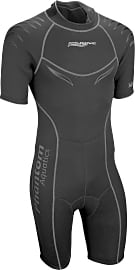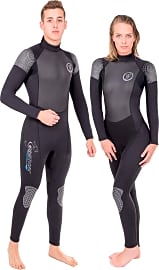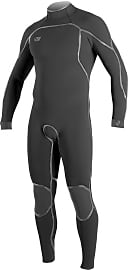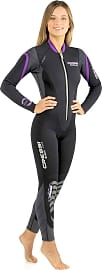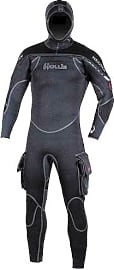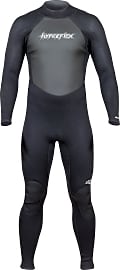The 10 Best Wetsuits

This wiki has been updated 39 times since it was first published in April of 2015. Whether you are a diver, a snorkeler, a windsurfer, a triathlete, a paddle boarder, or a water skier, you'll find one of these wetsuits perfect for your favorite sport or hobby. We've included both full-length options and shorties, as well as models designed for tropical and cold waters to ensure you stay warm and comfortable wherever you may be. When users buy our independently chosen editorial picks, we may earn commissions to help fund the Wiki.
Editor's Notes
January 15, 2020:
Not all wetsuits are created equal, so staying warm in the water is all about picking the right one. If you generally swim in the spring or any other time when the water stays above 70 degrees or so, a 3/2 shorty wetsuit like the Phantom Aquatics Men's Marine Shorty, will be well-suited to your needs. However, if you plan on taking your surfboard out on very windy days, you may be better off with a long-sleeve option with a short leg cut like the Billabong Women's Spring Fever, as it can help keep the wind chill at bay while still allowing full freedom of movement below the waist.
Full 3/2 suits like the O'Neill Men's Reactor II, O'Neill Psycho One Z.E.N., and NeoSport Premium S832WB are perfect if the water temperature may drop as low as 60 degrees. Alternately, you could go with a straight 3- or 2.5-mm option like the Seavenger Odyssey, Cressi Lady Front-Zip Full, and Hyperflex 3mm Full Body.
If you will be in seriously frigid temperatures, you should opt for a very thick suit like the Hollis Neotek Semi-Dry, which has multiple pockets to stash gear and incorporates a hood to help prevent heat loss through the head.
Since we realize that some people use wetsuits for triathlons, rather than diving or surfing, we decided to include the Zoot Sports Z Force 1.0. It features a special coating that reduces its friction and helps the wearer glide through the water more quickly, and it offers plenty of flexibility in the arms and legs.
While we still stand by most of our recommendations from last year, we did decide to get rid of the Rip Curl Dawn Patrol due to reports of it wearing out quickly. We also eliminated the Cressi Women's Summer because of the tendency of the colors to fade from sun exposure, and we replaced the O'Neill Men's Reactor with its newer iteration, the O'Neill Men's Reactor II.
Special Honors
Patagonia R1 Lite Yulex The R1 Lite Yulex is fair-trade certified and made from mostly natural rubber sourced from sustainable forests, and recycled polyester, so it is good for the planet and the workers who make it. All of its seams are triple glued, and it is 100-percent internally taped, which means it should stand up to plenty of use. patagonia.com
Quintana Roo Hydrosix If you are a serious triathlon, then you may want to consider the pricey, but high-quality Quintana Roo Hydrosix. It has just 27 seams to help eliminate pressure points and restrictions and a hydrodynamic buoyancy profile that promotes efficient swimming technique. quintanarootri.com
The History Of The Wet Suit
In the later Renaissance, technological development finally began to alter the ways in which people entered the water.
Human beings have taken to the water for tens of thousands of years. Ancient accounts of deep sea free diving tell of men routinely reaching depths of 100 feet or more below the surface for the purposes of harvesting sponges, shells, coral, pearls, and to salvage items from sunken ships. Ancient swimmers took part in everything from competitions to military campaigns, with aquatic soldiers serving as everything from scout to saboteur.
In the later Renaissance, technological development finally began to alter the ways in which people entered the water. Developments like the diving bell allowed a person to spend longer periods of time underwater in relative safety, though accidents were frequent enough, and usually tragic in nature. Diving bells were employed throughout the 17th and 18th centuries, most often for salvage work aimed at recovering the cannons, gold and silver, and other goods lost with sunken ships.
The early 1700s saw the first diving "dresses", which were designed to permit greater control by the person within and included the ability to control watertight sleeves that stuck out from the hard walled devices. Rather than merely a veritable underwater room, these diving dresses at least conformed to the general shape of their occupant, though range of motion was still dramatically curtailed.
The 1800s saw the first true diving suits. Usually made from layers of leather and/or watertight fabric, and with the iconic copper diving helmet atop, diving suits of the 1830s finally allowed for true movement by a diver under the water connected to the surface by a hose (or a series of hoses). Dive times were extended and what a diver could accomplish while submerged grew in proportion.
The next great advance in diving technology came in the 20th century, when self-contained underwater breathing apparatuses (better known as SCUBA gear) first came to the fore. Liberated from tethers connecting them to the surface, divers could now range far and wide of their own accord, the implications of which were not lost on any of the major combatants during WWII. Frogman was the name given to soldiers of the era who would often approach targets underwater to conduct sapping missions or to collect intelligence.
Scuba gear would continue to develop apace throughout the rest of the century. In the mid 1900s, there was one more major development in aquatic gear: the development of the wetsuit. Credit for the conception of the wetsuit goes to a physicist working out of Berkeley, CA named Hugh Bradner. He first posited the idea that insulation provided by a thin layer of semi-porous fabric could preserve enough heat for comfortable protracted use even in cold waters, and conducted research to identify the ideal material and arrangement of the aquatic garments.
Bradner was more interested in science than in sales, however. His idea, revealed in 1951, would be seized upon by others and, by the end of the decade, commercial wetsuits were cropping up far and wide. They were soon put to use by everyone from military divers and rescue swimmers to surfers and beyond. The pairing of the lightweight, warm, and flexible wetsuit and the ever-improved, ever-more-compact scuba systems available to the public would revolutionize sport and commercial diving in particular.
How The Wetsuit Works
Contrary to popular belief, wetsuits don't work by warming up the water trapped between the body and the suit; not exactly, at least. While that water is gradually warmed to a comfortable degree, the suits actually work by trapping in body warmth with the gas bubbles trapped in their own fabric.
To avoid this, the modern wetsuit usually employs two layers of neoprene with a layer of a more durable rubber or spandex sandwiched between them.
Neoprene, the fabric most commonly used in wetsuits, can hold millions of minute nitrogen bubbles within its fibers, and these bubbles form a layer of reliable insulation against the ambient chill of the water. This is the concept that was first understood in a practicable way by Hugh Bradner.
The issue with neoprene is its inherent weakness and tendency to tear or to be easily punctured. Early wetsuits required their user to don them with the greatest care, and could easily become damaged to the point of uselessness. (Suits with large rips or that have been stretched out allow for so-called washing, which is when cold water rushes into the warmed wetsuit, thereby undoing its thermal properties.) To avoid this, the modern wetsuit usually employs two layers of neoprene with a layer of a more durable rubber or spandex sandwiched between them.
Choosing The Right Wetsuit For Your Needs
Before you chose a wetsuit, you have to consider both the types of aquatic activities in which you participate and the places in which you will be swimming, surfing, or diving. In general, it's a good idea for most recreational users to wear only as much wetsuit as they need given water temperature and personal comfort levels.
In general, it's a good idea for most recreational users to wear only as much wetsuit as they need given water temperature and personal comfort levels.
Shortie wetsuits that cover only the upper thighs, torso, and upper arms are fine for mild to cool waters in which the wearer is only looking to maintain a warmer core temperature. These suits are great for surfers in particular, as the activity is already prone to elevate body heat, and as freedom of motion is important.
Full-body wetsuits are often called steamers, a name gleaned from the steam released after a user removes his or her suit on a cool day. These neck to ankle suits can be augmented with booties and hoods for extremely cold waters, and many have double seals at the neck, wrists, and ankles which can keep their wearer almost totally protected from the cold water all around.
For the competitive or distance swimmer, there are specially made wetsuits that are thin, sleek, and have a water repellent finish that helps their user glide though the water with minimal effort.


